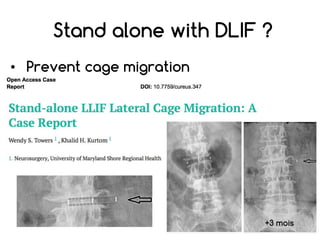What Does Dlif Mean
The realm of spinal surgery has witnessed a plethora of advancements that are invaluable for patients seeking relief from debilitating back pain. One particular surgical technique that continues to garner attention is the Direct Lateral Interbody Fusion, commonly referred to as DLIF. But what exactly does DLIF mean, and why has this method caught the fascination of both medical professionals and patients alike?

At its core, DLIF is a minimally invasive surgical approach utilized for spinal fusion, primarily aimed at addressing degenerative disc diseases, scoliosis, and other spinal deformities. The fundamental objective of this technique is to stabilize the spine by fusing two or more vertebrae together, thus allowing for enhanced structural integrity and alleviated pain. This procedure specifically involves accessing the lumbar spine through the side of the body, circumventing major muscles and tissues, which contrasts sharply with traditional posterior or anterior approaches.
One of the most compelling aspects of DLIF is its promise of reduced recovery time. Conventional spinal surgery often necessitates extensive incisions, extended hospital stays, and lengthy rehabilitation periods. In contrast, DLIF leverages small incisions that can lead to significantly less postoperative discomfort and faster recovery trajectories. Patients frequently express a sense of wonder at how a procedure that seems so intricate can yield such swift and impactful results. This phenomenon raises fascinating questions about the physiological healing mechanisms activated by minimally invasive techniques.
Digging deeper, the effectiveness of DLIF also hinges upon the meticulous surgical precision required during the procedure. Surgeons employ advanced imaging technology to navigate the complex anatomy of the lumbar region, ensuring that the interbody cages are placed with exceptional accuracy. This dexterous manipulation not only aids in achieving optimal alignment but also minimizes the risk of complications. The use of such sophisticated techniques has opened new avenues for understanding the intricacies of spinal anatomy and the vital importance of precision in surgical outcomes.
The nomenclature "DLIF" itself is a succinct yet intriguing designation. It encapsulates the essence of the procedure, conveying a directness that resonates with both medical practitioners and patients. The term "direct" underscores the approach’s straightforward nature, while "lateral" indicates the side-access technique—an anatomical pivot that has engendered much curiosity and admiration within the surgical community.
Moreover, fascination with DLIF stems from its broader implications in the field of spinal surgery. The evolution toward less invasive techniques reflects a pivotal shift in surgical philosophy. Surgeons today are more attuned to patient-centered care models, emphasizing minimized trauma and maximal outcomes. This progression merits attention as it not only transforms individual patient experiences but also reshapes the paradigms of surgical training and practice.
Equally captivating is the role of technology in facilitating DLIF. The integration of computer-assisted navigation, intraoperative imaging, and advanced surgical instruments epitomizes the marriage of medicine and technology. Surgeons now possess an arsenal of tools that enhance the efficacy of procedures, allowing them to visualize the surgical field with remarkable clarity. This technological revolution exhilarates those within the medical field while also engendering hope among patients who are keen on exploring innovative treatment options for chronic back ailments.
As we dissect the DLIF procedure further, it becomes apparent that the technique also addresses a significant concern often left unspoken: the psychological aftermath of spinal surgery. Patients frequently grapple with anxiety and uncertainty regarding their surgical outcomes, which can cloud their perception of the procedure. The relative simplicity and efficacy of DLIF serve as a reassurance, instilling confidence in patients confronted by the daunting prospect of back surgery. It embodies not just a physical intervention but also a psychological refuge, elevating the overall patient experience.
Furthermore, exploring the outcomes associated with DLIF evokes deep curiosity about long-term impacts. Studies demonstrate promising results regarding pain relief, mobility restoration, and overall patient satisfaction. Yet, the questions remain: How do these immediate benefits translate into long-term health? What is the enduring impact on patients’ quality of life? These inquiries invite a broader discourse on the sustainability of surgical interventions and their implications on the aging population.
In closing, DLIF stands as more than just an abbreviation for Direct Lateral Interbody Fusion; it represents a significant advancement in surgical technique that resonates deeply with patients and healthcare providers alike. Its unique approach, technological integration, and focus on minimally invasive practices encapsulate a significant shift in spinal surgery. Beyond the surgical table, DLIF beckons a deeper exploration into the realms of patient care, recovery, and the future of spinal health. In a world where back issues are prevalent, the continued fascination with DLIF not only highlights its merits but also invites further inquiry into the evolving landscape of spine surgery. The future promises even more revolutionary advances, leaving both patients and practitioners eager to see what lies ahead.
Post a Comment